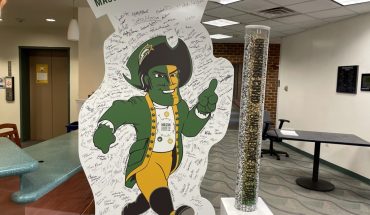BY RICHARD HRONIK STAFF WRITER
Picture this. You sign up for a media production class expecting to be able to use high-tech equipment for your projects. A few weeks in, you find out that unless you spend thousands of dollars to buy your own materials, your best option will be an equipment rental system that is greatly constrained by the pandemic.
It’s no secret that the COVID-19 pandemic has made things quite difficult for Mason students, regardless of what classes they were taking. But students in media production classes have had it especially hard.
These classes normally involve students borrowing equipment for different aspects of the curriculum. For example, prior to the pandemic, COMM 208 — Introduction to Media Production — would involve projects that gave students hands-on opportunities to learn how to use multimedia tools. That includes things that most people don’t just have lying around in a drawer somewhere, like thousand-dollar cameras and lighting equipment.
Now it’s a rather different story. The shift to online learning has forced changes in media production classes, and video equipment can be hard to come by.
There are two options for students seeking to rent equipment for their media production projects on campus. The first is STAR Lab. Short for Student Technology Assistance and Resource, STAR Lab has a selection of cameras and lights available seven days a week, but the main constraint here is the window of time you have for this equipment. With only four-hour rental periods, students would need to either make multiple reservations or use their time very wisely.
This service is available to all students — not just those taking media production classes. While it is admirable to provide access to this equipment to more students, it makes this service less viable for media production students.
The second option is the Student Video Center. Available exclusively to media production students, SVC offers equipment rentals through the Cheqroom app. Officially, equipment rented from SVC is due back in 24 hours. It’s possible to take advantage of the office’s hours to have the equipment for longer since the office isn’t open seven days a week. But those limited hours are a double-edged sword in that students are constrained to being on campus on those specific days to pick up and drop off their equipment.
I got on Zoom with Professor David Miller, who was the main driving force behind getting SVC back up and running this past summer, to get a little more information.
As he put it, “[One challenge] would be that the Student Video Center normally has five to six employees, and we are usually open from 10 a.m. to 7 p.m. five days a week. And we would normally have many more classes using the SVC. But now we have a smaller group of students, and we only have two staff members.”
This limited number of staff constrains the SVC’s hours. Is it possible that more staff could be brought in to allow the SVC to be open for more hours during the week? With the pandemic waning, it’s certainly possible that we could see restrictions being lessened, and more people being allowed in. We’re starting to get to a point where things could be better from a staffing standpoint, if campus authorities allow them to be.
All things considered, it’s good that the SVC is even open. They knew that media production classes would be at a major disadvantage without access to that equipment and they did what was necessary to make sure students could get the equipment they needed.
Could they do better? In a perfect world, of course. But given the current circumstances? I think they’re doing all they can. Like so many other things, they are constrained by COVID-19 regulations. And it seems as though they won’t be able to do much more until we reach a point where those restrictions can be dropped.



